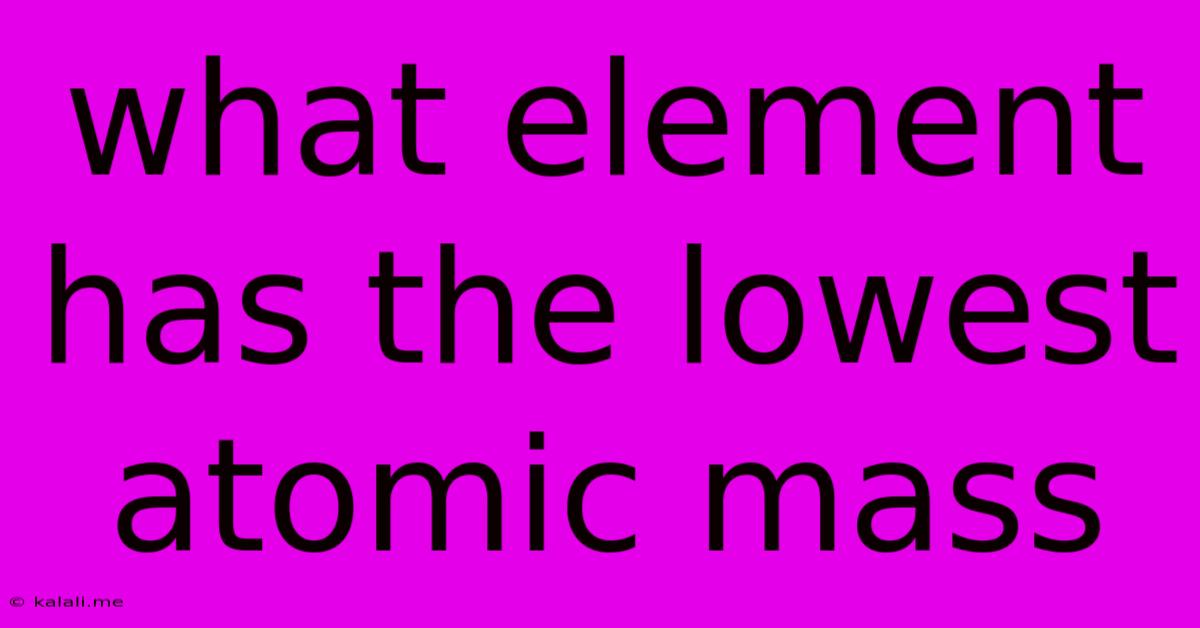What Element Has The Lowest Atomic Mass
Kalali
Jun 14, 2025 · 3 min read

Table of Contents
What Element Has the Lowest Atomic Mass?
Hydrogen, the simplest and most abundant element in the universe, holds the title of having the lowest atomic mass. This article delves into the reasons behind this, exploring the concept of atomic mass and its significance in chemistry and physics. Understanding hydrogen's unique position on the periodic table provides a foundational understanding of elemental properties and the building blocks of matter.
Understanding Atomic Mass
Atomic mass, also known as atomic weight, represents the average mass of atoms of an element, considering the relative abundances of its isotopes. Isotopes are atoms of the same element with the same number of protons but a different number of neutrons. This difference in neutron count leads to variations in mass. The atomic mass listed on the periodic table is a weighted average, reflecting the natural isotopic distribution of the element. It's measured in atomic mass units (amu), where one amu is approximately the mass of a single proton or neutron.
Hydrogen's Unique Properties
Hydrogen boasts the lowest atomic mass because its most common isotope, protium (¹H), contains only one proton and no neutrons in its nucleus. This gives it an atomic mass of approximately 1 amu. While other isotopes exist, deuterium (²H) with one proton and one neutron, and tritium (³H) with one proton and two neutrons, their presence in nature is significantly less compared to protium. This drastically influences the average atomic mass, which remains the lowest among all elements. This simplicity in its atomic structure contributes to its unique chemical and physical properties.
Comparing Hydrogen to Other Light Elements
To further solidify hydrogen's claim, let's compare it to other elements with low atomic masses:
- Helium (He): Helium, the second lightest element, has an atomic mass of approximately 4 amu. This is significantly higher than hydrogen due to the presence of two protons and two neutrons in its most common isotope.
- Lithium (Li): Lithium, with an atomic mass of approximately 7 amu, has a considerably larger atomic mass due to the increased number of protons and neutrons in its nucleus.
The stark difference in atomic mass between hydrogen and these other light elements showcases hydrogen's unique position at the very beginning of the periodic table.
Significance of Low Atomic Mass
The low atomic mass of hydrogen has far-reaching implications:
- Nuclear Fusion: Hydrogen's low mass is crucial in nuclear fusion reactions, the process that powers stars. The fusion of hydrogen isotopes, particularly deuterium and tritium, releases immense energy.
- Chemical Reactivity: Hydrogen's single electron allows for a wide range of chemical reactions, making it a vital component in numerous compounds.
- Abundance in the Universe: Its low mass contributes to its abundance, making it a fundamental building block for molecules across the cosmos.
Conclusion
In conclusion, hydrogen's remarkably low atomic mass, stemming from its simple atomic structure, makes it unique among all elements. This property contributes significantly to its role in various natural processes and technological applications, highlighting its importance in chemistry, physics, and astrophysics. Its position as the lightest element is a cornerstone of our understanding of the universe and the fundamental forces that shape it.
Latest Posts
Latest Posts
-
How Does Representative Democracy Differ From Direct Democracy
Jun 14, 2025
-
Is Dembele Right Or Left Footed
Jun 14, 2025
-
The Ends Of A Long Bone Are Known As The
Jun 14, 2025
-
Most Abundant Metal In The Earth Crust
Jun 14, 2025
-
The Area Under A Velocity Time Graph Represents
Jun 14, 2025
Related Post
Thank you for visiting our website which covers about What Element Has The Lowest Atomic Mass . We hope the information provided has been useful to you. Feel free to contact us if you have any questions or need further assistance. See you next time and don't miss to bookmark.